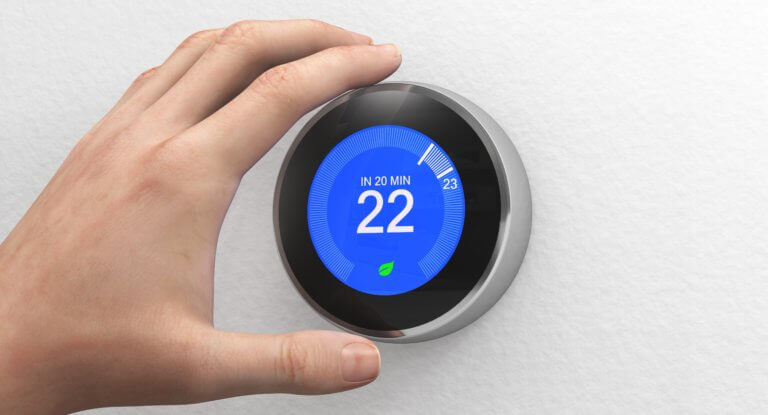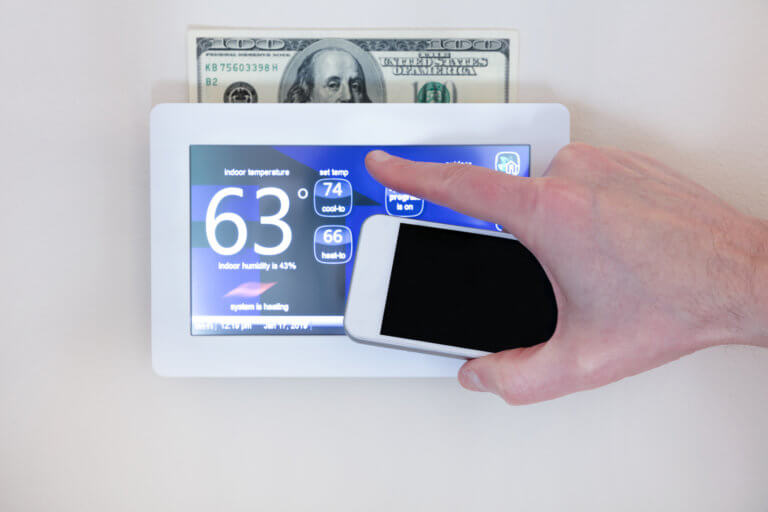Smart homes are becoming more and more popular these days, with everything from Amazon Alexa to refrigerators that automatically update your grocery list based on what’s inside, and more. Homeowners everywhere are looking for anything to help make their home more efficient and environmentally friendly, and help them save money. Heating and cooling account for a large portion of energy consumption in homes, so owners and tenants are often going to WiFi-enabled smart thermostats to help combat this, and reap other benefits as well.
How Smart Thermostats Work
Smart thermostats are made up of three main parts. The first part connects directly into your HVAC system. This then communicates directly with the second part, the thermostat control itself – AKA the controller on your wall. The third part of a smart thermostat is the app, which is downloaded to your phone, mobile device or computer. These three basic components working together allow you to interact with your thermostat wirelessly in a variety of ways. Some other, “smarter” models may offer even more perks. For example, some offer learning models, which do not require programming but rather adjust to your lifestyle as it learns patterns such as certain times of day that you’re home. Some may also offer mobile tracking, or automatically adjusting temperatures as your phone gets within a certain range so it’s a nice temperature when you walk in your door. And some may even offer additional sensors for things like zoned temperature control.

Benefits of Smart Thermostats
Smart thermostats offer a variety of benefits for heating and cooling your home – from more control over your home’s temperature and climate to advantages beyond temperature control. Check out some of the main benefits of installing a smart thermostat below:
-
- Save energy and costs – Smart thermostats have been proven to help homeowners save money on heating and cooling bills each month by conserving energy. WiFi-enabled thermostats allow you to schedule certain temperature settings for certain times of the day. For example, you can schedule your home’s temperature to shift up or down (depending on the time of year) while you’re at work, and schedule it to go back to a more comfortable position when you’re home. This helps save energy and money and keep your home more environmentally-friendly.
- Remote access – The majority of smart thermostats allow homeowners to connect to their devices via WiFi. These thermostats contain sensors that control the heating and cooling systems and work in conjunction with your HVAC system. This means you have the ability to control your home’s temperature, even if you’re not at home, by connecting to WiFi and getting on the app that comes with the thermostat. This is a great function if you ever forget to turn your thermostat down before leaving for work or vacation!
- Maintenance reminders – Smart thermostats can track information for you such as when you last changed your air filter. When the time comes to change to a new one, your smart thermostat will remind you. Once again helping you make your home as energy-efficient as possible.
- Monitor energy consumption – Many smart thermostats will monitor your use and energy consumption week-by-week, and show you if you’ve gone up or down. This, in turn, helps you become smarter about how you program your thermostat, which helps you save money and be more environmentally friendly.

Difficulties of Smart Thermostats
There are a few potential difficulties of smart thermostats that are important to note before deciding if it’s the way to go for you. Below are some things to consider when looking into getting a smart thermostat:
- Not needed if you’re home most of the time – If you are often home for whole days at a time or if you work from home, a smart thermostat may not be needed. When you’re home, you want the temperature to be set to a comfortable degree, and the pro of a smart thermostat when you don’t work from home is turning it up or down while you’re gone during the day to save energy and cost.
- Cost to install – The initial cost of a smart thermostat can be a bit high. The installation can be difficult, and often needs a professional to be done properly, which costs money. So while the month-to-month savings will kick in once installed, the actual device and installation can be a high cost.
- Have to learn how to use – Using a smart thermostat properly takes some educating. To get the most out of your system, you’ll need to read the manual and learn the details, which some people don’t want to take the time to do.
[/fancy-ul][vc_column_text]Smart homes are becoming increasingly popular amongst homeowners and tenants. Anything to make the day-to-day more convenient for themselves is a plus. Smart thermostats are a great step in that direction – and while they do come with some potential difficulties, the pros – such as saving money and energy, and remote access – highly outweigh the cons.
Contact us today to learn more about how your HVAC system will work best with a smart thermostat.

